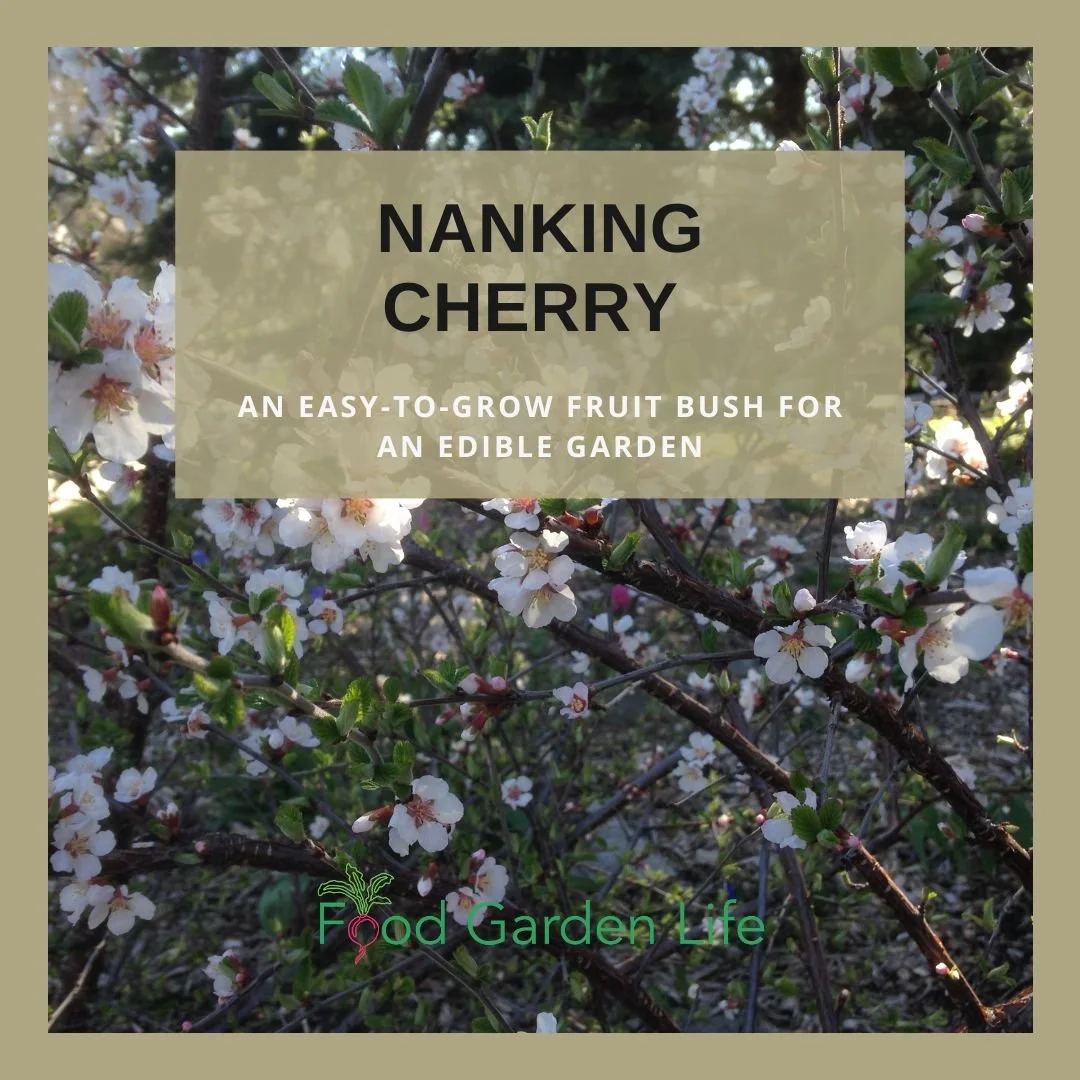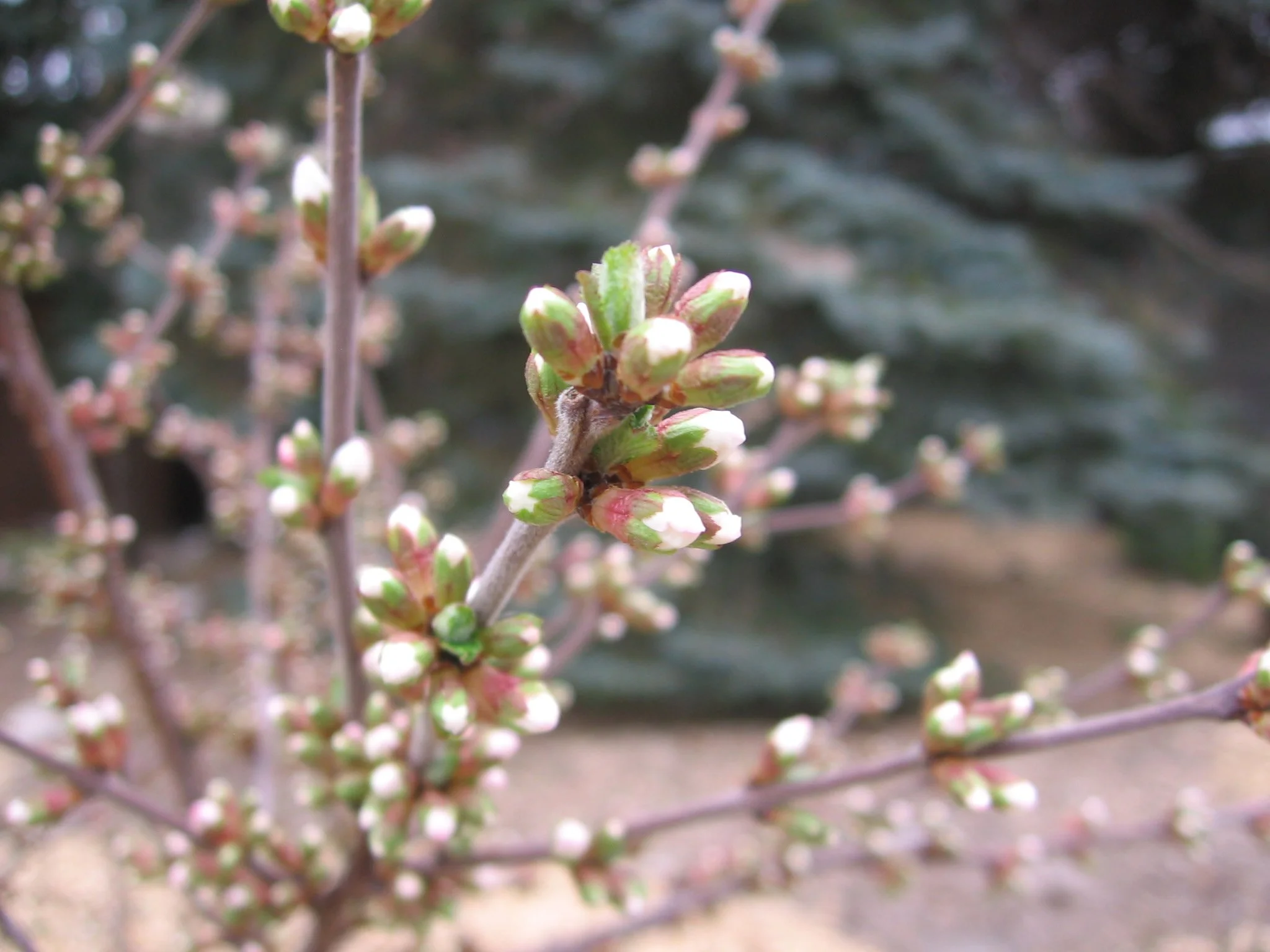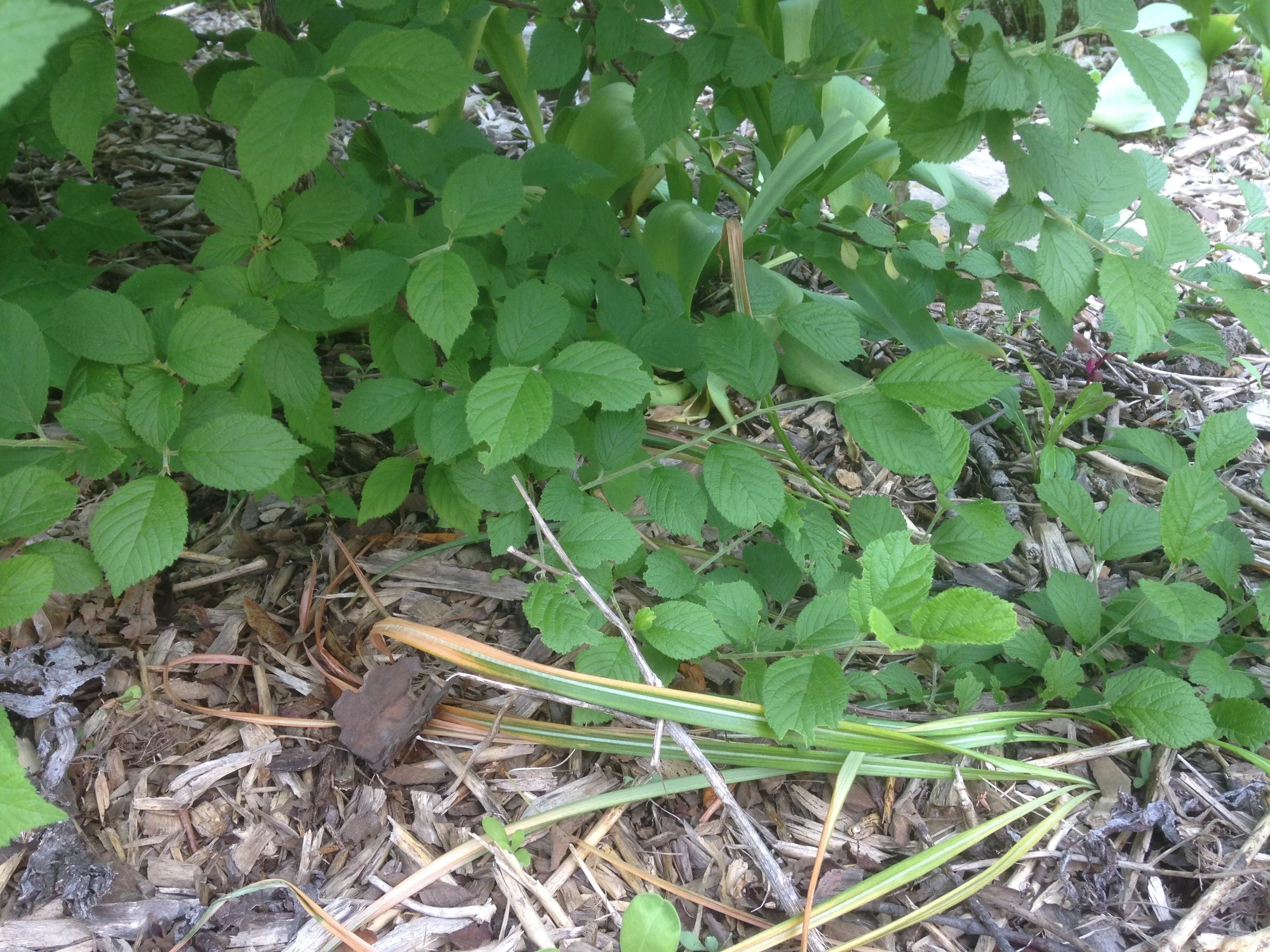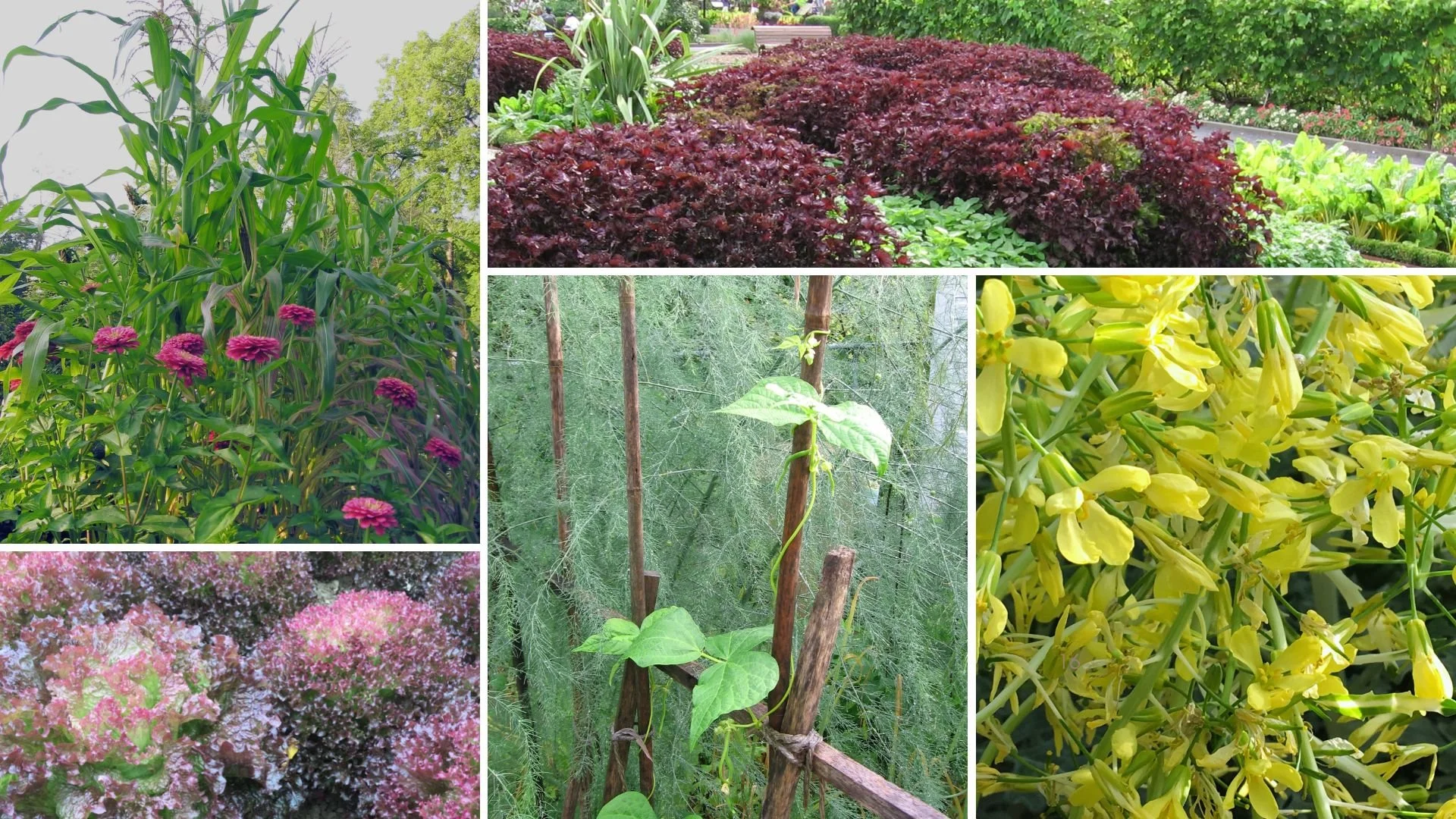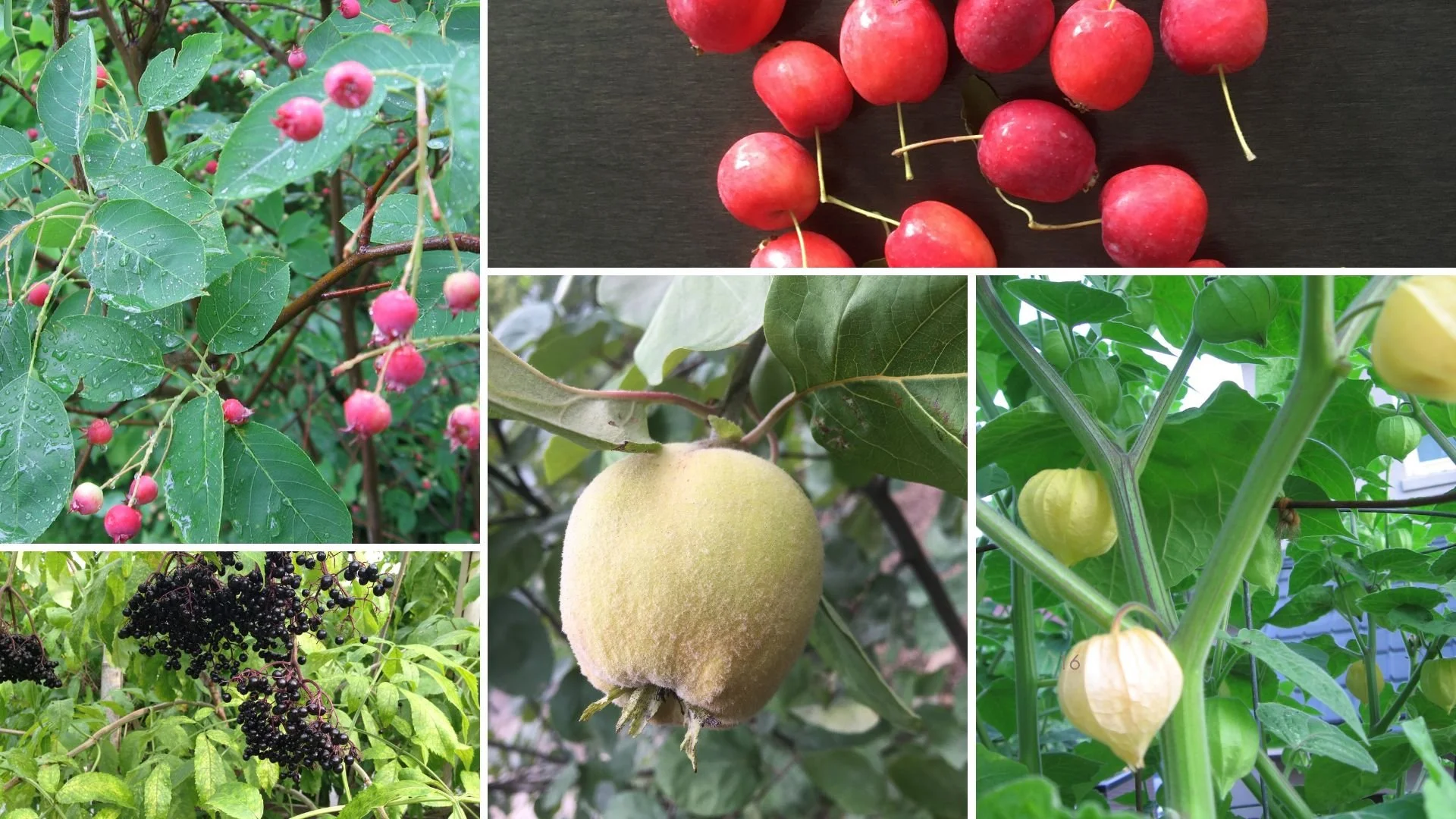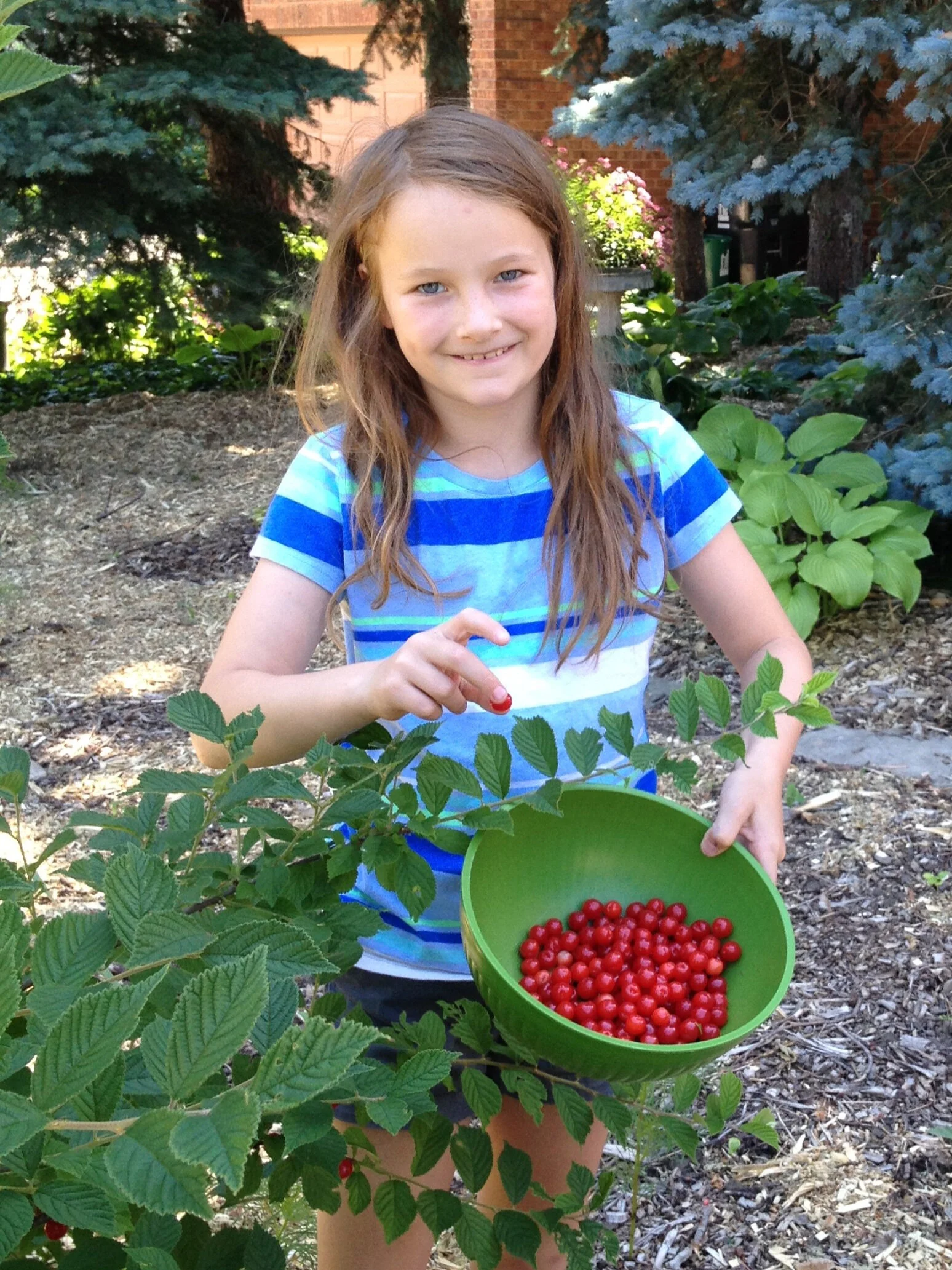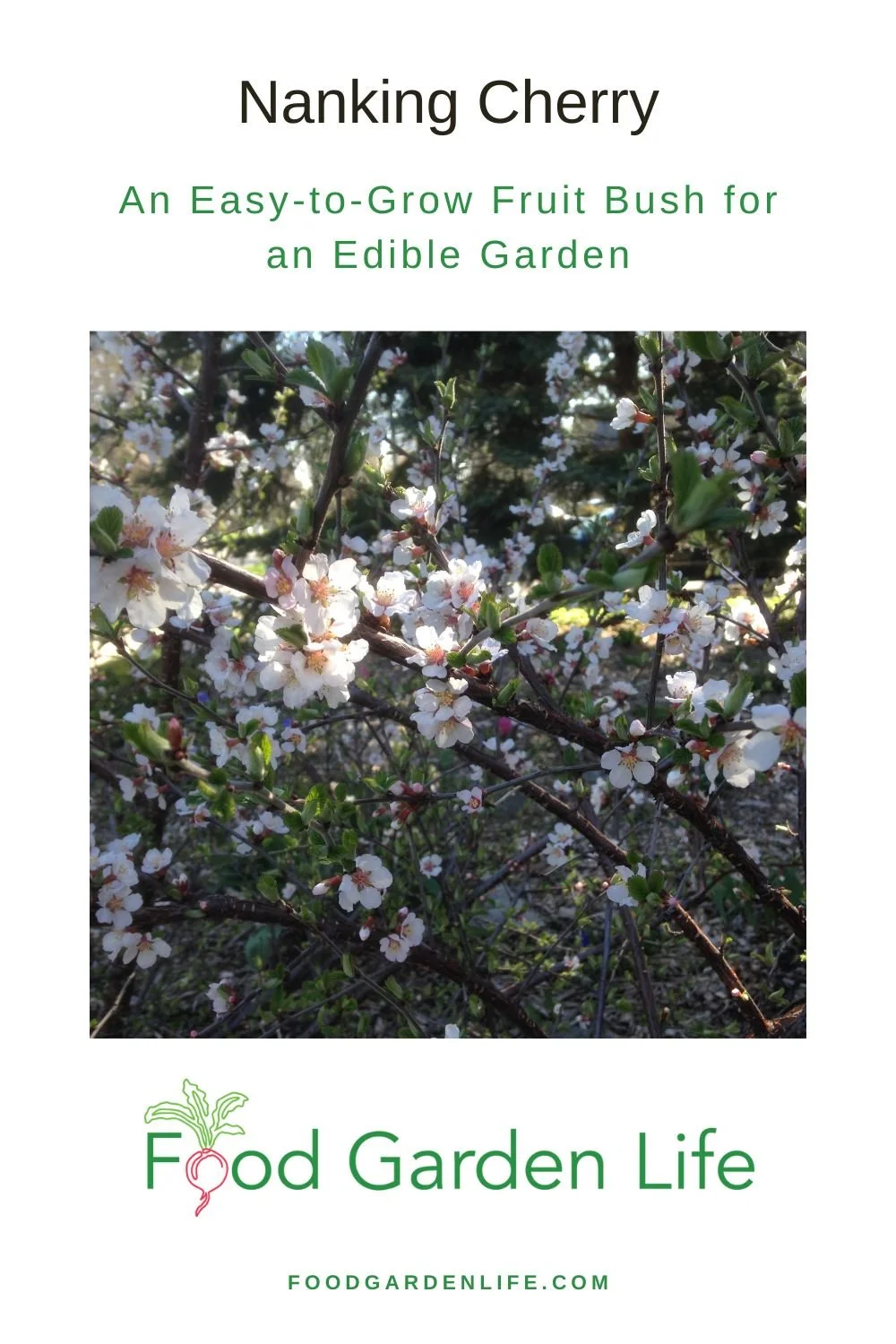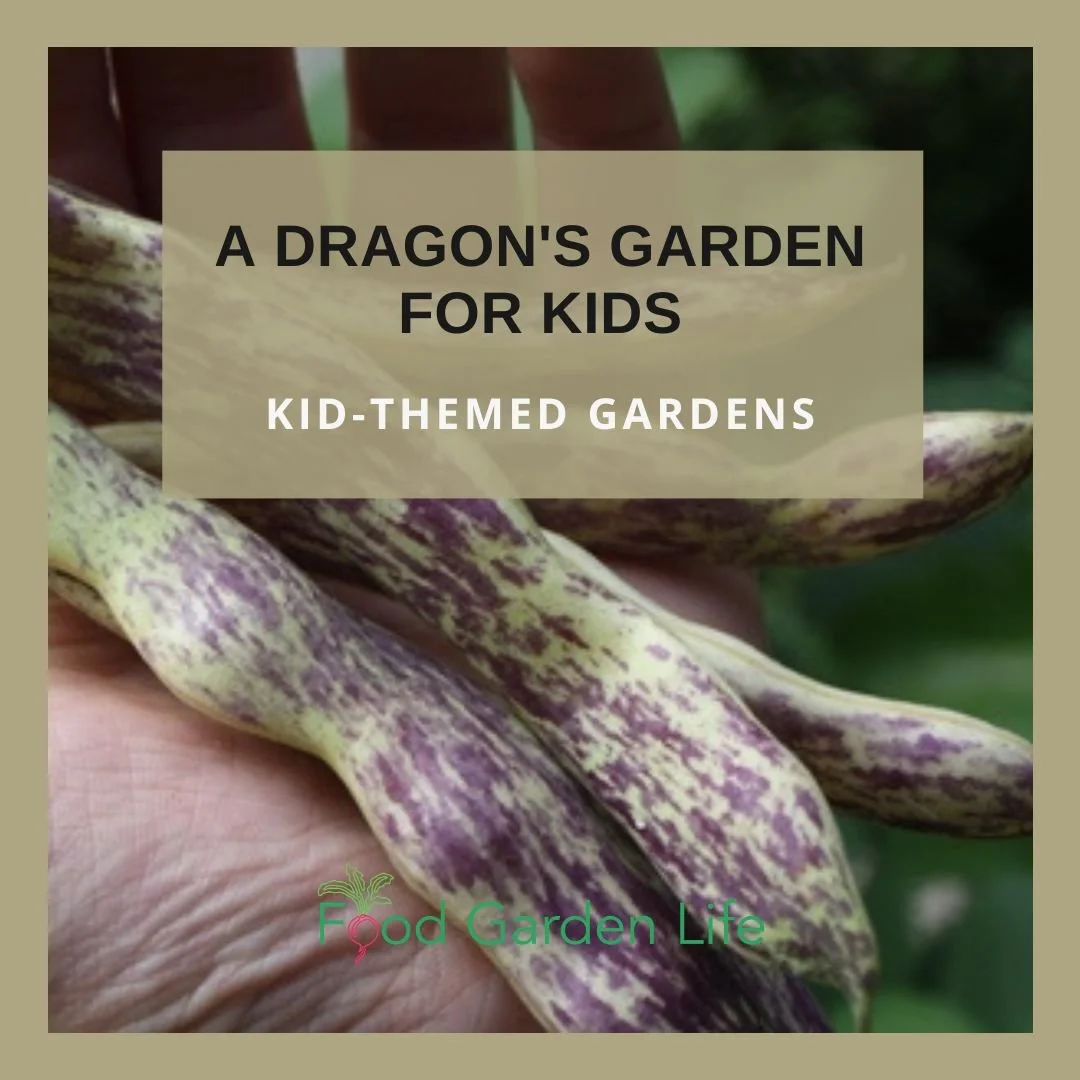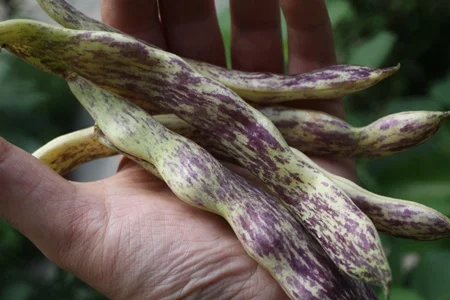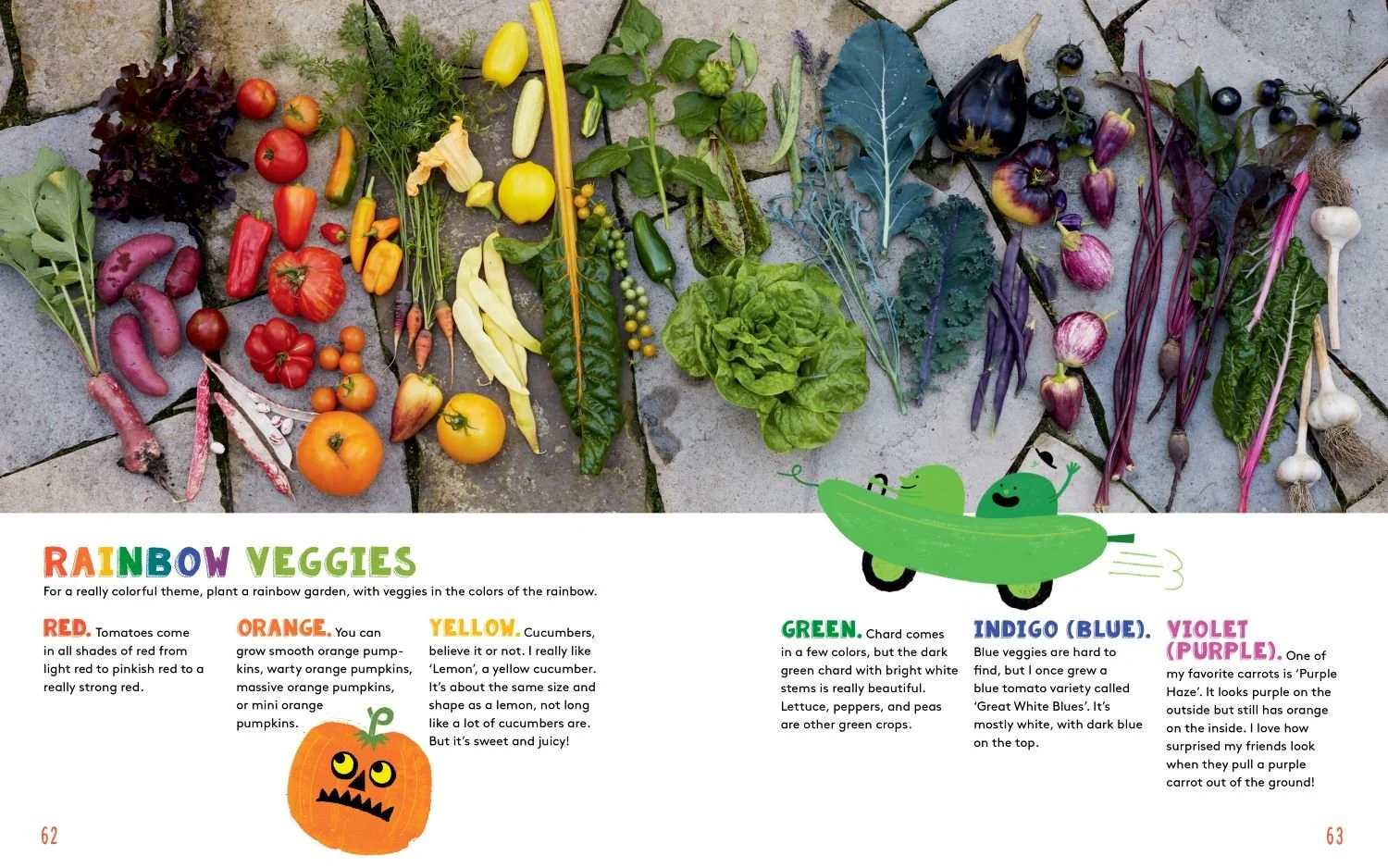Find out how to grow sorrel, and get ideas for creative sorrel recipes.
Skip the Transplants: Direct Sowing Seeds
Fruit Bush for an Edible Garden: Nanking Cherry
By Steven Biggs
Grow Nanking Cherry
The Nanking cherry bush has a spectacular bloom early in the spring.
“Dad, someone’s taking a picture of your garden,” shouts one of the kids. It’s early May, so I know which plant will be in the photo.
The Nanking cherry, a.k.a. Prunus tomentosa. Even though our front garden is a party of spring flowering bulbs, when the Nanking cherry is blooming, it steals the show.
The Nanking cherry bush is like a stop sign. Pedestrians going past our house change gears from a brisk walk to a full stop and then take photos.
Spring isn’t the only time it looks great: it looks great again as the fruit colours up. And unlike cherry trees, where you have to look upwards, this cherry bush is at eye level.
Perfect Fruit for a Home Garden
Nanking cherry is ideal for a home food garden because it’s compact, ornamental, and easy to care for. By comparison, many fruit trees require a fair bit of pruning and pest and disease management. And they take more space.
The small, bright-red cherries are juicy. I’d place the taste somewhere between sweet and sour cherries.
Where to get Nanking Cherry
Nanking cherry flower buds
When I teach about edible landscapes, most students haven’t heard of Nanking cherry because it’s not too common in the horticultural trade. It’s a pity because this is such a fantastic home garden fruit bush.
Look for a nursery specializing in fruit and cold-hardy plants. Or, better yet, find somebody who is already growing it, because many of the seeds that drop around the bush will grow.
(I once mentioned this to my class and was asked by students if that meant I had extras to share. I did. And I took in a tray of small cherry bushes the following class.)
By Seed
While many fruit trees and bushes are propagated commercially by cuttings or grafting, Nanking cherry is commonly seed grown. You can grow them from seed at home:
Look for small Nanking cherry plants growing from seed near a mature, fruit-bearing bush.
When saving seeds to grow, don’t let them dry out too much
In the fall, place seeds in damp potting soil
Store potted seeds in a cold location until spring (a fridge or animal-free shed or garage is fine)
In spring, watch them grow!
When you grow from seed, the seedlings will all be genetically distinct, so expect some variability between plants. Seed-grown plants often flower in less than five years.
Cuttings
If you have a Nanking cherry plant that you really like, you can also propagate it from cuttings. Root softwood cuttings in early summer, as fruit ripens, or root cuttings from dormant hardwood in the spring. High humidity and rooting hormone increase the percentage of cuttings that root.
Enjoy playing with colour, texture, and shapes?
Don’t want a cookie-cutter veggie garden?
If you've thought of growing more of your own food, but you don’t know what to do next, Edible Garden Makeover gives you the ideas, knowledge, and inspiration to grow food in a way that fits your yard and your style.
Layering
Another way to propagate Nanking cherry is by layering. This is the practice where a low-lying branch is covered with soil until it grows roots and can be detached from the main plant. I find it’s often enough to simply to pin a low-lying branch to the soil by covering it with a brick.
Nanking Cherry Varieties
Red-fruited, white-flowered varieties of Nanking cherry are the most common in the horticultural trade.
There are not a lot of improved varieties available commercially. At the time of writing this, I’ve just ordered one called ‘Pink Candles.’
Along with the common seed-grown, white-flowered, red-fruited Nanking cherry varieties, look for:
White-fruited varieties
Pink-flowered varieties (like ‘Pink Candles, above)
Cold-Climate Cherry
If you’re gardening in a cold zone, Nanking cherry withstands cold winters and hot summers. My grandfather grew Nanking cherry in Calgary, a mercurial climate if ever there was one. His cherry bushes soldiered on through snow in summer and balmy winter chinook winds.
(Incidentally, he also made wine from Nanking cherry, although I was too young at the time to partake!)
Cold hardiness is never an exact science as there are many variables. But this is a very cold hardy plant, surviving winter temperatures as low as -40°C (-40°F).
Pick a Location for your Nanking Cherry
Sunlight: Full sun is best. As with many crops, if you only have partial sun, it’s worth a try. You’ll still likely get something.
Soil: Well-drained soil, enriched with compost.
Snow load: Winter snow coverage is, if anything, helpful, as it insulates the bush. I have one next to my driveway, and it’s covered every year with heaps of snow.
Covering more than 20 fruits, the focus is easy-to-grow fruit suited to northern gardens. Fruits include cherry-family crops, currants, cane fruit such as raspberry and blackberry, elderberry, serviceberry and saskatoon, haskap, plum family, medlar, melon, husk cherries...and more! Find out more here..
Prune Nanking Cherry
One of the things that makes fruit bushes far more suited to home gardens is that the burden of pruning is less. You can prune annually if you want – and you’ll be rewarded with a nicer form and more yield. But if you’re busy and don’t get around to it, that’s fine too.
Timing: Prune in late winter.
Size: Remember, as the gardener, you decide the final height of your Nanking cherry bush. Depending on the growing conditions, it will get to 1.5 – 3 metres high (5 – 10 feet). Bushes can get fairly wide if space permits.
I keep mine pruned to about 1.5 metres (5’) high. That’s because I don’t want it to block the sight line between my garden and the sidewalk. And another important consideration is not to let the bush get any higher than you can pick!
In general, pruning that encourages young branches encourages more fruit. Keeping the canopy open with pruning helps to minimize the chance of any diseases because there is good air circulation. Pruning tips:
Remove some of the older branches
Trim out dead branches
Cut out crossing branches
Prune to shorten the bush
Nanking Cherry Pests and Diseases
Nanking cherry is in the same family as cherries and plums, which are affected by a number of pests and diseases. But I’ve never found the need for pest or disease control.
The one challenge I occasionally encounter is branch dieback where leaves on a branch dry up, and the branch eventually dies. Some sources attribute this to fungal diseases. For dieback, prune affected branches back to the main stem.
Harvesting Nanking Cherries
We eat lots of our Nanking cherries right in the garden! But they are versatile in the kitchen too.
Nanking cherries are an early summer fruit. Around here, that means that I’m picking them around the same time as strawberry season is finishing up.
Unlike sweet and sour cherries, where the stem is left attached to the fruit when picked, the stubby little stems on Nanking cherry stay on the bush. As a result, the fruit don’t last as long as other cherries.
Nanking Cherry in the Kitchen
The kids and I sometimes stand around a bush and guzzle cherries and then see who can spit the seeds the farthest. And that’s an important point I should make: like all cherries, there’s a pit!
Use Nanking cherries for whatever recipes call for sour cherries. I also freeze some for winter use. Because of the size, they are a bit fiddlier to pit than larger cherries.
Here are ways we enjoy using Nanking Cherry:
Nanking cherry juice
Nanking cherry compote
Nanking cherry bump (not for the kids!)
And…one other food related idea: I consider cherry wood the finest wood for smoking meat. So when I prune my Nanking cherry, I keep the branches to use for smoking.
Nanking Cherry FAQ
Do I need more than one Nanking cherry bush?
Many sources report the need for two bushes for cross pollination. I started out with one bush – the only one in the neighbourhood – and had good fruit set. There are reports of some self-fertile varieties.
When should I move my Nanking cherry bush?
The best time to move it is in the spring, while it’s still dormant.
Can I grow my Nanking cherry bush in shade?
It will grow best in full sun, but can grow respectably well in part sun/shade. Just know that you probably won’t get as much fruit as you would if it were growing in a full-sun location. As home gardeners we don’t always have perfect conditions.
Can I grow my Nanking cherry in a wet location?
Well drained soil is best. If the water table is high, consider growing in a raised bed.
What about animal pests eating the Nanking cherries?
The birds will like them just as much as you do. But unlike large tree fruit, such as apples and peaches, there’s much more to share when we grow small-fruited crops such as cherries.
Should I cover my Nanking cherry if there’s a frost?
The flowers are early in the season, when the risk of frost is still high. Most years I still get good fruit set here in Toronto. I’ve had reduced fruit set caused by a freeze once in a dozen years.
Find This Helpful?
If we’ve helped in your edible-gardening journey, we’re always glad of support. You can high-five us below! Any amount welcome!
More on Growing Cherries
Find out about 5 Types of Cherry Bush to Grow in Edible Landscapes and Food Forests
Hear Dr. Ieuan Evans talk about the Evan’s Cherry
More on Growing Fruit
These Courses Can Help you Grow Your Own Fruit
Move Over Bedding Plants...and Try These Edible Garden Plants Instead
Replace some of your bedding plants with edible plants! Find out how to choose suitable crops to use as bedding plants.
A Dragon's Garden for Children (Toothy, Pointy, Spiny Plants!)
By Steven Biggs
Kids Gardening…with Fun Themes
A dragon-themed garden never occurred to me.
It was Finn’s idea.
Finn and him mom came to my daughter Emma’s talk about gardens for children.
She told the kids they didn’t have to garden like grown ups. They could make their gardens fun.
Grow a tickling garden with plants that are good for tickling
A purple garden
Or a giant’s garden with giant sunflowers and mammoth pumpkins
Then Emma told the kids about one of her favourite plants that year: a bean with unusual markings called ‘Dragon Tongue.’
Finn Decides on a Theme Garden
The next morning Finn’s mom sent us a note. He loved the ‘Dragon Tongue’ bean. He loved dragons.
So he decided he’d grow a dragon-themed garden.
Dragon Tongue beans for a dragon-themed garden. (Photo by Emma Biggs)
Emma and I loved Finn’s idea.
So we scoured seed websites for dragon-themed plants. Here’s what we came up with:
Dragon’s Egg cucumber
Purple Dragon carrot
Red Dragon arugula
Tongue of Fire bean
Snapdragon…and there are so many sizes and colours
Dragon’s Toe pepper
Green Dragon cucumber
Thai Dragon hot pepper
Blue Dragon dracocephalum
Flower Dragon watermelon
Black Dragon coleus
Taking the Dragon Idea Further
Then we thought about how we’d describe a dragon. We came up with ideas like spiny, toothy, winged, and pointy.
That helped us find even more plant ideas for the dragon-themed garden:
Litchi tomato for spiny skin!
Toothy. (An agave looks pretty toothy to my imagination. Or, if you want to stretch things, dandelion comes from French—dent-de-lion—which means "lion's tooth.” I even found a daylily called ‘Snaggle Tooth.’)
Long and pointy for the tail. (Corn? …I’ll let the kids brainstorm this one.)
Leathery or spiny for dragon-like skin. (I’m picturing citrus rind here; and Litchi Tomato would be perfect!)
Serpent-like shape. (I think snake gourds might work!)
Wings (How about a winged bean, angel wing begonia…or maybe something with winged seeds such as maple?)
I’m sure there are lots more plants with a dragon connection. E-mail us if you have any to add to the list!
Another Themed Garden
Check out the picture below of the harvest from Emma’s rainbow-themed garden.
A Rainbow-themed garden, from the book Gardening with Emma.
More theme ideas:
Pizza garden
Salsa garden
Bug’s garden (maybe include logs and rocks that kids can lift up to hunt for bugs)
More Ideas for a Garden for Children
Kids Gardening Articles and Interviews
Kids Gardening Books
Want fun books to inspire the kids in your life to explore the garden? Here are kids gardening books, signed by the author, Emma Biggs.
Driveway Makeover! 5 Ideas for Growing a Container Garden for Vegetables
A container vegetable garden is a good way to fit lots of vegetable crops into a small space. Find out how to get started.
Guide: Growing Raspberries (high yield, NO fuss fruit)
Edible Flowers: Flowers You Can Eat (AND how to use them)
Edible flowers: Find out which flowers are edible—and how to use them to spice up your cooking and culinary creations.
Vegetables to Grow: 12 Tips to Choose What’s Best for Your Vegetable Garden
Seed Company List: Where to Buy Vegetable Seed
Wood Ash for the Garden: What You Need to Know
Find out whether wood ash is good for your garden. It can be used as a fertilizer and to make the soil less acidic.
Shopping for Nut Trees? Find Out Where to Buy Nut Trees and Nut Bushes
Prevent Leggy Seedlings and Grow Vegetable Transplants Like an Expert
The best way to solve the problem of spindly seedlings is to prevent them from getting that way in the first place. Find out how.
Seed Shopping Smarts: Know The Lingo So You Can Get The Best Seeds
What’s your seed-shopping vocabulary like? Brush up on your seed lingo in this glossary of seed terminology so you can choose the best seeds for your needs.

